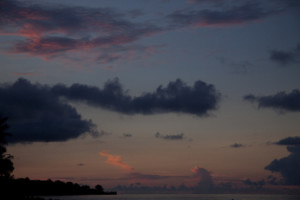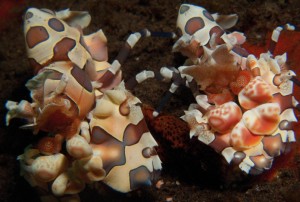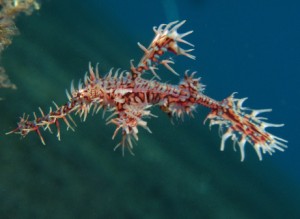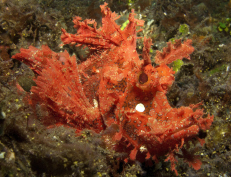News
Seraya surprises

Sometimes the problem with international diving is that I am overambitious. I travel really far to arrive at a country that I have never been to, and then I travel even further to actually go diving. But it isn’t always necessary in Indonesia. I have often overlooked Bali as a world-class dive destination in favor of other more famous places in Indonesia, such as Raja Ampat and Komodo. I had touched down in Bali several times and viewed a lot of beautiful macro photographs taken at dive sites on the island so I was curious to dive there myself. But each time I traveled to Indonesia, I found somewhere else to go. My previous trip to Indonesia had a final tally of thirteen flights, including six international and seven domestic. It felt like a world tour of airports and in one day in Indonesia alone, I had to board three different planes, which meant navigating a total of four different airports, each with different rules for transit (yes, my passion for diving is great).
 When I booked my recent boat trip to Komodo (May 2013), I wanted an extension, one without extra planes, and asked for a destination on Bali. Ultimate Dive Travel recommended Scuba Seraya on the northeast coast of Bali, but the suggestion came with two warnings. The first was that the drive to the resort from Denpasar was long and maybe just as time consuming as a flight to somewhere else in Indonesia. The drive is along a two-lane highway that twists and turns through tropical foliage and Balinese rice terraces. Fairly beautiful views over a three-hour drive. The second precaution was that Scuba Seraya was an incredibly quiet place. It is. I am not sure what other people are looking for when they go diving, but warm water with unusual creatures is enough “busy” for me. Add to that, beautiful clean black sand beaches, a view of the main volcano on Bali (Mount Agung), views of the sunrise and sunset, and that is Scuba Seraya.
When I booked my recent boat trip to Komodo (May 2013), I wanted an extension, one without extra planes, and asked for a destination on Bali. Ultimate Dive Travel recommended Scuba Seraya on the northeast coast of Bali, but the suggestion came with two warnings. The first was that the drive to the resort from Denpasar was long and maybe just as time consuming as a flight to somewhere else in Indonesia. The drive is along a two-lane highway that twists and turns through tropical foliage and Balinese rice terraces. Fairly beautiful views over a three-hour drive. The second precaution was that Scuba Seraya was an incredibly quiet place. It is. I am not sure what other people are looking for when they go diving, but warm water with unusual creatures is enough “busy” for me. Add to that, beautiful clean black sand beaches, a view of the main volcano on Bali (Mount Agung), views of the sunrise and sunset, and that is Scuba Seraya.
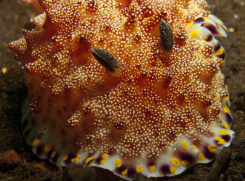 When I was there in May 2013, it was a shoulder season so very few guests were at the resort. One dive guide was assigned to two guests for the duration of their stay. Ours was Alit who had been with the resort for 10 years. The area, which includes Tulamben, is popular amongst scuba divers because of the Liberty Wreck located just a few meters from the shore. Scuba Seraya is a 5-minute zodiac ride from Tulamben. The torpedoed ship was originally towed to this spot for repairs in 1942, but a volcanic eruption 50 years ago moved it into the sea. It now lies at its deepest point in about 30 meters of water. The advantage of staying at Scuba Seraya is that you have the opportunity to be among the first to view the wreck in the morning. Later in the day, divers arrive from the main areas of Bali and descend upon the site by late morning. 50 years has only added beauty to this wreck rather than taken it away. It is encrusted with colorful soft corals, sponges, anemones, and crinoids, and many larger animals frequently cruise this site. We saw a green turtle, a big Maori Napolean wrasse, and bumphead parrotfish, which travel in a school that you can see if you are coerced into the 6 to 6:30 AM dive.
When I was there in May 2013, it was a shoulder season so very few guests were at the resort. One dive guide was assigned to two guests for the duration of their stay. Ours was Alit who had been with the resort for 10 years. The area, which includes Tulamben, is popular amongst scuba divers because of the Liberty Wreck located just a few meters from the shore. Scuba Seraya is a 5-minute zodiac ride from Tulamben. The torpedoed ship was originally towed to this spot for repairs in 1942, but a volcanic eruption 50 years ago moved it into the sea. It now lies at its deepest point in about 30 meters of water. The advantage of staying at Scuba Seraya is that you have the opportunity to be among the first to view the wreck in the morning. Later in the day, divers arrive from the main areas of Bali and descend upon the site by late morning. 50 years has only added beauty to this wreck rather than taken it away. It is encrusted with colorful soft corals, sponges, anemones, and crinoids, and many larger animals frequently cruise this site. We saw a green turtle, a big Maori Napolean wrasse, and bumphead parrotfish, which travel in a school that you can see if you are coerced into the 6 to 6:30 AM dive.
The wreck is the main dive attraction to this area, but the rest of the diving is not the B-movie. There were all sorts of creatures to hunt for that were new to me, and there was time to look because there was no one else but my dive buddy and me. On Drop-off Wall, we went straight down to look at a pygmy seahorse. For me, it was unexpected because we were hardly far from the shore and already down around 25 meters was a hippocampus Denise on a gorgonian fan. I can only guess how many times this particular pygmy seahorse has appeared on the Internet in photos taken by people from all over the world. He was one of my better chances to photograph one, but he still made my job as underwater paparazzo difficult because he would not look into the camera.
 Some of the dive sites in the area are given names that add a level of spirituality to the dive if you do not already feel it. Alamanda, “one with nature”, and Melasti, “purification”, were two such dives that illustrated the remarkable diversity of nature underwater and perhaps the ritual of diving them helps you to throw your problems into the sea. You can not help but be removed from the world above when you get to view a pair of robust ghost pipefish, a pair of spiny tiger shrimp, and some abnormally large nudibranchs that I have yet to name. Indigenous “Serayan” I call them for now. They could not exactly be considered macro, and I had to wonder what it is they eat.
Some of the dive sites in the area are given names that add a level of spirituality to the dive if you do not already feel it. Alamanda, “one with nature”, and Melasti, “purification”, were two such dives that illustrated the remarkable diversity of nature underwater and perhaps the ritual of diving them helps you to throw your problems into the sea. You can not help but be removed from the world above when you get to view a pair of robust ghost pipefish, a pair of spiny tiger shrimp, and some abnormally large nudibranchs that I have yet to name. Indigenous “Serayan” I call them for now. They could not exactly be considered macro, and I had to wonder what it is they eat.
Since I have a special fondness for anemones, I have to mention the anemone garden that was at the dive site Coral Gardens. I had heard about one that exists in a more remote location in the Alor Archipelago of Indonesia, but there was an expansive one here that you could easily swim to from shore!
Scuba Seraya has a house reef, which was generally scheduled as a shore dive in the afternoon. Right out in front of us, we found three ornate ghost pipefish and some resident harlequin shrimp radiating light and color against darkness at depth and the lava derived sand. They seemed to have been glued to their starfish like some kind of porcelain figure, and the funny thing about these shrimp is that while they are so beautifully delicate and seem to “rest” upon the sea star, they are actually slowly eating it over time.
New critter uploads to my brain continued into the night dives. To be able to expand my critter database at Scuba Seraya, was an impressive follow-up to a 12 day, 39-dive liveaboard trip in Komodo National Park. Alit had enthusiastically approached me for the night dives. “You are going for a night dive, right?” as if I had it already scheduled. His eagerness made me think that he wanted to use me more as his own dive buddy rather than the other way around. A whole different set of nudibranchs as well as their shell retaining cousins had emerged from the sand in the transition from sunlight to darkness. One of his most spectacular finds was an unbelievably tiny frogfish that I could only tell was a frogfish by the way it moved. My awe at his find was clearly expressed underwater, and Alit’s discovery was an example of knowing his reef environments really well.
One creature that is a sort of two-for-one, is the boxer crab. It is a small crab that holds two tiny anemones in its claws and raises them in self-defense. The anemones get transport and maybe food particles to eat. I again missed the locale that boxer crabs normally inhabit, but each night, Alit would motion me over and present a crab, including one carrying eggs one night. These boxer crabs were bold, and instead of scurrying away from me, they instigated a game of chicken or stare down. Their intention was unclear, but the game resulted in some successful photos for me.
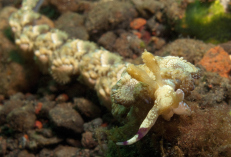 We only had time enough to dive the area near the resort. The region is much more expansive, extending down the coast, south to Amed. It was not part of my original plan to want to come back for further dive exploration on Bali, but now I do. The young Indonesians guiding the dives at the resort proudly claimed that Tulamben/Seraya is the best diving on Bali because the locals practice conservative fishing methods whereas other notable areas on the island do less so. It is a photographer’s dream destination as it is not crowded, so you have time with your subject, nor is it littered topside or on the sea floor. On the other hand, the fine black sand is a nightmare for housings!
We only had time enough to dive the area near the resort. The region is much more expansive, extending down the coast, south to Amed. It was not part of my original plan to want to come back for further dive exploration on Bali, but now I do. The young Indonesians guiding the dives at the resort proudly claimed that Tulamben/Seraya is the best diving on Bali because the locals practice conservative fishing methods whereas other notable areas on the island do less so. It is a photographer’s dream destination as it is not crowded, so you have time with your subject, nor is it littered topside or on the sea floor. On the other hand, the fine black sand is a nightmare for housings!
The most amazing part about diving Scuba Seraya is that you are never very far from shore. So the next time your feet are dangling while you are catching the waves at the beach, wherever you are, think about who is under them.
Gear News
Introducing the TR-80, IR-50 and CS-30 Regulators from DYNAMICNORD

Whether you are a beginner or a professional diver – with the three new main regulators from DYNAMICNORD, everyone will find their favourite regulator. They all look super stylish.
Excellent performance with the TR-80
Quality and performance are the be-all and end-all for regulators. It is not for nothing that the TR stands for Tec Reg. The innovative design of the TR-80 guarantees absolute reliability – even in ice-cold waters.

Perfect breathing effort at 0.8 J/l / certified for diving in waters below 10 degrees / structural design made of solid brass for best cold protection / membrane-compensated design with dry seal of the first stage / reduced exhalation effort thanks to optimized exhalation membrane and bubble deflector / adjustable Venturi (dive/predive) and adjustment knob for individual inhalation comfort / innovative design of the front cover prevents free-flow in strong currents or when diving with scooters / design made of sandblasted brass, matt chrome finish / 2 HP and 4 LP outlets / mouthpiece made of high-quality, anti-allergic silicone for maximum comfort.


Amazing underwater adventures with the IR-50
The IR-50 is the top regulator for advanced and experienced divers. Natural breathing is the essence of this regulator.

Ideal breathing effort at 0.8 J/l /certified for diving in waters below 10 degrees / compensated membrane / adjustable venturi (dive/predive) and adjustment knob for individual inhalation comfort/ outlet valve and deflector for minimum exhalation effort and reduction of bubbles on the face / design made of sandblasted brass, matt chrome finish / 2 HP and 4 NP outlets / mouthpiece made of high-quality, anti-allergic silicone for maximum comfort.


The Workhorse – our CS-30
For diving centres and diving beginners – the workhorse stands for strong construction, reliability and robustness. Perfect for your training.

Optimal breathing effort at 0.8 J/l /recommended for diving in waters above 10 degrees / non-compensated piston / adjustable venturi (dive/predive) / outlet valve and deflector for minimum exhalation effort and reduction of bubbles on the face / design made of sandblasted brass, matt chrome finish / 1 HP and 3 NP outlets / mouthpiece made of high-quality, anti-allergic silicone for maximum comfort.


Octopus OP-30
The OP-30 is the ideal addition to all DYNAMICNORD regulators. It is identical in construction to the CS-30.

The TR-80, IR-50, CS-30 (DIN & INT) regulators and the Octopus OP-30 are available from DYNAMICNORD dealers and in the online store.
DYNAMICNORD – Your Outdoor Companion.
Marine Life & Conservation
Paul Watson Released as Denmark Blocks Japan’s Extradition Bid

Renowned anti-whaling activist Paul Watson has been released from custody in Greenland after spending five months in detention. Denmark’s Justice Ministry rejected Japan’s request for his extradition, citing insufficient guarantees that his time already served in custody would be credited against any potential sentence.
The 74-year-old Canadian-American was arrested on July 21 in Nuuk, Greenland’s capital, when his ship docked to refuel. His arrest was based on a 2012 Japanese warrant related to a 2010 encounter in Antarctic waters. Japan alleged Watson obstructed operations and caused damage to a whaling research ship during efforts to disrupt illegal whaling. Watson has consistently denied these claims, maintaining his commitment to marine conservation.
Denmark, which oversees extradition matters for Greenland, concluded that while the legal conditions for extradition were met, the lack of assurances from Japan regarding time-served credit made extradition untenable.
In a video shared by his foundation, Watson expressed gratitude and relief, saying, “After five months, it’s good to be out… and good to know they’re not sending me to Japan.” He added that the most difficult part of his time in custody was being separated from his two young sons.
Watson is a pioneering figure in marine conservation, known for founding the Captain Paul Watson Foundation in 2022 after decades of activism with the Sea Shepherd Conservation Society. His bold efforts to defend marine life have earned him widespread support, including from celebrities and conservationists. His work has also been featured in the acclaimed reality TV series Whale Wars.
Watson’s lawyer, Jonas Christoffersen, praised the decision, stating, “We are happy and relieved that Paul Watson is now free.” He added that Watson is eager to reunite with his family and continue his vital work.
The arrest occurred while Watson’s vessel, the M/Y John Paul DeJoria, was en route to the North Pacific with a team of 26 volunteers to intercept a Japanese whaling ship. His foundation described the arrest as politically motivated and emphasized that Watson’s actions were focused on ending illegal whaling practices.
Japan resumed commercial whaling in 2019 after leaving the International Whaling Commission, asserting that whale meat is a cultural tradition. Conservationists, however, continue to challenge these practices, highlighting their impact on marine ecosystems.
Despite the challenges, Watson remains steadfast in his mission to protect marine life and bring attention to whaling practices. His dedication to ocean conservation has made him a globally respected advocate for the environment.
-

 News2 months ago
News2 months agoIconic SS United States to become the World’s Largest Artificial Reef
-

 News3 months ago
News3 months agoBook Review – 52 Assignments: Underwater Photography
-

 Gear News3 months ago
Gear News3 months agoDYNAMICNORD – New German diving brand enters the British market
-

 News3 months ago
News3 months agoExploring Cenote El Pit: A Diver’s Dream
-

 Gear News3 months ago
Gear News3 months agoTry BARE drysuits (and maybe even win one!) this Friday with Sea & Sea at North West Dive Fest
-

 Marine Life & Conservation3 months ago
Marine Life & Conservation3 months agoBook Review: Coral Triangle Cameos
-

 Blogs2 months ago
Blogs2 months agoDive the Egyptian Red Sea this Autumn with Regaldive
-

 News3 months ago
News3 months ago2024 Ocean Art Underwater Photo Competition Announced


